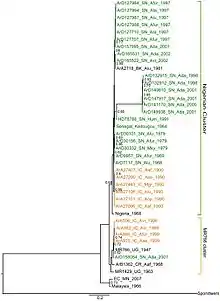Spondweni-Virus
Das Spondweni-Virus ist ein RNA-Virus aus der Familie der Flaviviridae, Gattung Flavivirus, nahe verwandt mit dem Zika-Virus (ZIKV), vom International Committee on Taxonomy of Viruses jedoch nicht mehr als eigenständige Spezies registriert (möglicherweise ein Subtyp on ZIKV).[3] Es ist der Auslöser des Spondweni-Fiebers.
| Spondweni-Virus | ||||||||||||||||||||
|---|---|---|---|---|---|---|---|---|---|---|---|---|---|---|---|---|---|---|---|---|
| Systematik | ||||||||||||||||||||
| ||||||||||||||||||||
| Taxonomische Merkmale | ||||||||||||||||||||
| ||||||||||||||||||||
| Wissenschaftlicher Name | ||||||||||||||||||||
| Spondweni virus | ||||||||||||||||||||
| Kurzbezeichnung | ||||||||||||||||||||
| SPONV | ||||||||||||||||||||
| Links | ||||||||||||||||||||
|
Eigenschaften
Das Spondweni-Virus ist als Arbovirus klassifiziert und wird durch Stechmücken der Familie Culicidae übertragen.[4][5] Die Reservoirwirte sind vermutlich nichtmenschliche Primaten.[6]
Struktur
Genom
Wie andere Flaviviren besitzt es ein RNA-Genom positiver Polarität von etwa 11 Kilobasen.[6] Es besitzt ein offenes Leseraster, aus dem ein Polyprotein gebildet wird.
Virusproteine
Das Polyprotein wird durch Proteolyse in zehn virale Proteine gespalten. Darunter befinden sich drei Strukturproteine: ein Kapsidprotein C (105 Aminosäuren), ein Prä-Membran/Membranprotein M (187 Aminosäuren) und das Hüllprotein E (505 Aminosäuren) sowie sieben Nichtstrukturproteine: NS1 (352 Aminosäuren), NS2A (226 Aminosäuren), NS2B (130 Aminosäuren), NS3 (Protease, 619 Aminosäuren), NS4A (127 Aminosäuren), NS4B (255 Aminosäuren), NS5 (RNA-Polymerase, 904 Aminosäuren).[6]
Virion
Das Virion besitzt einen Durchmesser von circa 50 Nanometer und eine ikosaedrische Form der Virushülle und des Kapsids, mit je drei Homodimeren des E-Proteins (Rezeptor, Transmembranprotein und fusogenes Protein) auf jeder Fläche der Außenseite.
Verbreitung
Bisher wurde das Spondweni-Virus in Nigeria (1952, ursprünglich fälschlicherweise als Zikavirus klassifiziert),[6] Südafrika (1955),[6] Kamerun,[6] Mosambik,[7] Burkina Faso[8] und Papua-Neuguinea entdeckt.[9]
Symptomatik
Die Symptomatik des Spondweni-Fiebers umfasst Fieber, Übelkeit, Kopf- und Gliederschmerzen und Nasenbluten.[10] Das Spondweni-Virus und das Zika-Virus erzeugen ähnliche Symptome und bilden eine gemeinsame Serogruppe, d. h., es gibt kreuzreaktive Antikörper.[5][11]
Systematik

Am nächsten ist es mit dem Zika-Virus verwandt, mit dem es eine Klade innerhalb der Moskito-übertragenen Flaviviren bildet.[12][13][14] Die epidemischen Varianten des Zika-Virus enthalten aus einer vergangenen Rekombination mit dem Spondweni-Virus einen gleichen Abschnitt im Protein NS2B des Zika-Virus.[15] Das Spondweni-Virus besitzt zwei Stämme, Chuku (Nigeria, 68 % identische RNA zum Zikavirus) und SA Ar 94 (Südafrika, 75 % identische RNA zum Zikavirus).[6]
Literatur
- B. M. MCINTOSH: Susceptibility of some African wild rodents to infection with various arthropod-borne viruses. In: Transactions of the Royal Society of Tropical Medicine and Hygiene. Band 55, Januar 1961, S. 63–68, PMID 13774008.
Einzelnachweise
- ICTV Master Species List 2018b.v2. MSL #34, März 2019
- ICTV: ICTV Taxonomy history: Yellow fever virus, EC 51, Berlin, Germany, July 2019; Email ratification March 2020 (MSL #35)
- F. A Murphy et al.: ICTV 6th Report
- B. M. MCINTOSH, R. H. KOKERNOT, H. E. PATERSON, B. DE MEILLON: Isolation of Spondweni virus from four species of culicine mosquitoes and a report of two laboratory infections with the virus. In: South African medical journal = Suid-Afrikaanse tydskrif vir geneeskunde. Band 35, August 1961, S. 647–650, PMID 13774006.
- A. D. Haddow, J. P. Woodall: Distinguishing between Zika and Spondweni viruses. In: Bull World Health Organ. (2016), Band 94, S. 711.
- A. D. Haddow, F. Nasar, H. Guzman, A. Ponlawat, R. G. Jarman, R. B. Tesh, S. C. Weaver: Genetic Characterization of Spondweni and Zika Viruses and Susceptibility of Geographically Distinct Strains of Aedes aegypti, Aedes albopictus and Culex quinquefasciatus (Diptera: Culicidae) to Spondweni Virus. In: PLoS neglected tropical diseases. Band 10, Nummer 10, Oktober 2016, S. e0005083, doi:10.1371/journal.pntd.0005083, PMID 27783682, PMC 5082648 (freier Volltext).
- R. H. KOKERNOT, B. M. McINTOSH, C. B. WORTH,. DE MORAIST, M. P. WEIN: Isolation of viruses from mosquitoes collected at Lumbo, Mozambique. I. Lumbo virus, a new virus isolated from Aedes (Skusea) pembaensis Theobald. In: The American journal of tropical medicine and hygiene. Band 11, September 1962, S. 678–682, PMID 14034311.
- M. S. Wolfe, C. H. Calisher, K. McGuire: Spondweni virus infection in a foreign resident of Upper Volta. In: Lancet. Band 2, Nummer 8311, Dezember 1982, S. 1306–1308, PMID 6128599.
- Stephen A. Berger, Charles H. Calisher, Jay S. Keystone: Exotic Viral Diseases.: A Global Guide, PMPH-USA, 2003, ISBN 9781550092059, S. 170.
- Thomas J. Chambers et Thomas P. Monath (Hrsg.), The Flaviviruses: Detection, Diagnosis and Vaccine Development: Detection, Diagnosis and Vaccine Development, Academic Press, 2003, ISBN 9780080493831. S. 376.
- O. Faye, C. C. Freire, A. Iamarino, O. Faye, J. V. de Oliveira, M. Diallo, P. M. Zanotto, A. A. Sall: Molecular evolution of Zika virus during its emergence in the 20(th) century. In: PLoS neglected tropical diseases. Band 8, Nummer 1, 2014, S. e2636, doi:10.1371/journal.pntd.0002636, PMID 24421913, PMC 3888466 (freier Volltext).
- R. S. Lanciotti, O. L. Kosoy, J. J. Laven, J. O. Velez, A. J. Lambert, A. J. Johnson, S. M. Stanfield, M. R. Duffy: Genetic and serologic properties of Zika virus associated with an epidemic, Yap State, Micronesia, 2007. In: Emerging infectious diseases. Band 14, Nummer 8, August 2008, S. 1232–1239, doi:10.3201/eid1408.080287, PMID 18680646, PMC 2600394 (freier Volltext).
- G. Kuno, G. J. Chang, K. R. Tsuchiya, N. Karabatsos, C. B. Cropp: Phylogeny of the genus Flavivirus. In: Journal of virology. Band 72, Nummer 1, Januar 1998, S. 73–83, PMID 9420202, PMC 109351 (freier Volltext).
- S. Cook, E. C. Holmes: A multigene analysis of the phylogenetic relationships among the flaviviruses (Family: Flaviviridae) and the evolution of vector transmission. In: Archives of virology. Band 151, Nummer 2, Februar 2006, S. 309–325, doi:10.1007/s00705-005-0626-6, PMID 16172840.
- Z. Zhu, J. F. Chan, K. M. Tee, G. K. Choi, S. K. Lau, P. C. Woo, H. Tse, K. Y. Yuen: Comparative genomic analysis of pre-epidemic and epidemic Zika virus strains for virological factors potentially associated with the rapidly expanding epidemic. In: Emerging microbes & infections. Band 5, März 2016, S. e22, doi:10.1038/emi.2016.48, PMID 26980239, PMC 4820678 (freier Volltext).